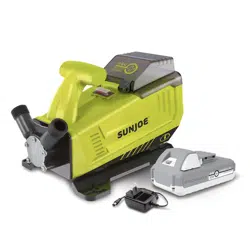Loading ...
Loading ...
Loading ...

13
5. Make sure the O-ring is properly seated and replace
impeller cover plate. Secure with the original 5 screws.
6. Secure the hoses and insert the battery, turn on the pump
to make sure there's no leaking from the impeller cover
plate.
Proper Care for Battery + Charger
mWARNING! To reduce the risk of injury, always unplug
the charger and disconnect the battery pack from the charger
before performing any maintenance task. Never disassemble
the battery pack or charger. Contact your Snow Joe
®
+
Sun Joe
®
dealer or the Snow Joe
®
+ Sun Joe
®
customer
service center for ALL repairs.
1. To reduce the risk of injury and damage, never immerse
your battery pack or charger in liquid or allow any liquid to
ow inside these components.
2. Clean out dust and debris from charger vents and
electrical contacts by blowing with compressed air.
3. Use only a soft, clean and dry brush to clean the battery
pack and charger, keeping away from all electrical
contacts. Certain cleaning agents and solvents are
harmful to plastics and other insulated parts. Some of
these include gasoline, turpentine, lacquer thinner, paint
thinner, chlorinated cleaning solvents, ammonia and
household detergents containing ammonia. Never use
ammable or combustible solvents around battery packs,
battery chargers or tools.
4. The iON+ lithium-ion battery chargers have no serviceable
parts.
Storage
Store the pump indoors in a dry, locked-up place out of
the reach of children, with the battery pack disconnected.
Disconnect and drain all hoses. Keep away from corrosive
agents such as garden chemicals and de-icing salt.
Battery + Charger O-Season Storage
1. Do not expose your battery pack or charger to water,
rain or allow them to get wet. This could permanently
damage the charger and the battery pack. Do not use oil
or solvents to clean or lubricate your battery pack as the
plastic casing can become brittle and crack, causing a
serious risk of injury.
2. Store the battery pack and charger at room temperature
away from moisture. Do not store in damp locations where
corrosion of terminals may occur. As with other battery
pack types, permanent capacity loss can result if the pack
is stored for long periods of time at high temperatures
(over 120ºF/49ºC).
3. iON+ 24Vlithium-ion battery packs maintain their charge
during storage longer than other battery pack types.
As a general practice, it is best to unplug the battery
charger and disconnect the battery pack when they are
not in use. Recharge the battery pack every 6 months to
50% capacity (2 lights on) during o-season storage to
maintain optimal battery performance.
Recycling + Disposal
The product comes in a package that protects it against
damage during shipping. Keep the package until you are sure
that all parts have been delivered and the product is functioning
properly. Recycle the package afterwards or keep it for long-
term storage.
WEEE symbol. Waste electrical products should not
be disposed of with household waste. Please recycle
where facilities exist. Check with your local authority
or local store for recycling regulations.
Battery Caution + Disposal
Always dispose of your battery pack according to federal,
state, and local regulations. Contact a recycling agency in your
area for recycling locations.
mCAUTION! Even discharged battery packs contain
some energy. Before disposing, use electrical tape to cover
the terminals to prevent the battery pack from shorting, which
could cause a re or explosion.
mWARNING! To reduce the risk of injury or explosion,
never burn or incinerate a battery pack even if it is damaged,
dead or completely discharged. When burned, toxic fumes and
materials are emitted into the surrounding atmosphere.
1. Batteries vary according to device. Consult your manual
for specic information.
2. Install only new batteries of the same type in your product
(where applicable).
3. Failure to insert batteries in the correct polarity, as
indicated in the battery compartment or manual, may
shorten the life of the batteries or cause batteries to leak.
4. Do not mix old and new batteries.
5. Do not mix Alkaline, Standard (Carbon-Zinc) or
Rechargeable (Nickel Cadmium, Nickel Metal Hydride,
or Lithium-Ion) batteries.
6. Do not dispose of batteries in re.
7. Batteries should be recycled or disposed of as per state
and local guidelines.
Loading ...
Loading ...
Loading ...
